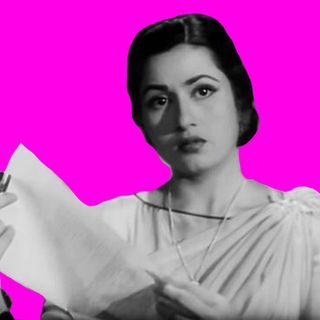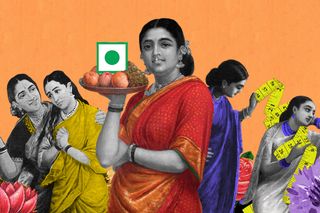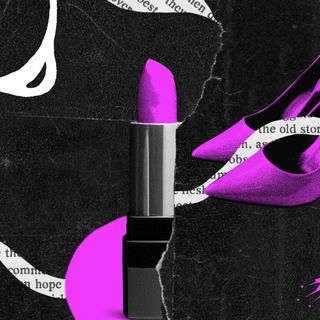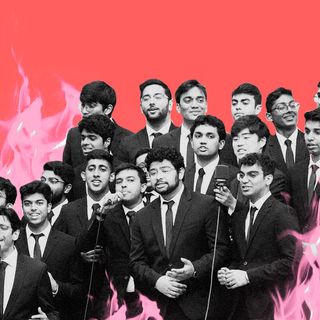
The Indian Arranged Marriage System Publicly Updated Its Vocabulary, But Remains Prejudiced Privately
Love may not be completely elusive within the arrangement, but it’s not integral either. Love, here, is merely an unguaranteed bonus.

Indian Matchmaking has infamously made the arranged marriage system appear twee and normal — sweeping its unsavory bits under the rug of vulnerability and humor. Meanwhile, on dating apps and matrimonial sites, many young Indians are looking for matches themselves — but only the kind their families would approve of; “arranged love,” in other words. In this pursuit, however, individuals end up filtering for caste, class, religion, and appearance markers — under the guise of modern, empowered millennials making their own choices. Meanwhile, courtesy of the plethora of content showcasing matchmaking and wedding spectacles on TV — and the Western gaze they endeavor to appeal to — the global audience has developed an obsession with arranged marriages in India. After all, they’re selling the cutesy spectacle of love, set against opulent backgrounds and glittering traditions; who doesn’t love love, right?
The illusion of freedom and agency thus attached to arranged marriages today, leads to many Indians being greeted with an unpleasant surprise once they actually submit to its rigors. “[T]he modern version of arranged marriages has been lauded for more than a decade now, one that gives those involved more freedom and agency — to go on dates, to get to know potential partners — supposedly stripping the age-old practice of its oppressive roots,” Rajvi Desai wrote in The Swaddle in 2020, pointing out the “how the distinction we’re so eager to make… doesn’t really exist. The process is still Brahmanical and casteist; it promotes harmful beauty standards of fair skin and height; and it reduces love and life-long partnership to a transaction, like ‘ordering things off a menu.’ No matter how the process is carried on in the modern-day, it cannot escape its roots.”
Not much has changed indeed. Prior to the digital era, matrimonial ads in newspapers would include ads stating things like: “Very fair divorcee boy earning 18 lpa wants to marry very beautiful girl” or “Fair, h’some, unmarried, well-settled Gujju 47/5’8″ seeks rich business industrial family girl.” Now, matrimonial sites are catering to the same societal biases through search filters. A leisurely scroll down the Indian subreddit on arranged marriages makes it evident how the concept facilitates endogamy and business transactions rooted in bigotry.
There’s nothing wrong in finding a match that one’s family approves of, many say — perhaps, less as a justification, and more as a coping mechanism for the loneliness that singledom has otherwise been tainted with. But the blurring distinction between the perceptions of “love” and arranged marriage also bears scrutiny — especially since the former implies a semblance of equality between the binary genders, when the fact is that marriage has, historically, been an inherently unfeminist, casteist institution. Designed to control women through notions of purity attempted at curbing their sexuality, marriages have long been an instrument to uphold caste endogamy. Disguised as parampara (tradition), pratishtha (honor), and anushaasan (discipline), the fundamental objective of arranged marriages is endogamy, not love. Although love may not be completely elusive within the arrangement, it’s not integral to it either. Love, in the universe of arranged marriages, is merely an unguaranteed bonus.
However, the misguided idea that love is, somehow, a part of the hallowed dynamic of traditional marriages has indeed made it more palatable to a modern generation, globally. “On Instagram, engagement announcements repeat and multiply into a single, glowing image. An image repeated enough times gradually feels like the correct version of how the world should look… But when I survey the experiences of the wider circle of straight women in my life, it’s not a stretch to question how much weddings distract us, like a bright shiny object, from thinking more seriously about the compromises we are willing to make in our relationships generally and married lives specifically,” notes an article. “[T]he ‘Wedding Industrial Complex’ bamboozles us… to make money, but also to distract us from the fact that even though marriage is more equal than it has ever been, it still generally makes men’s lives better and women’s more compromised and difficult.”
Related on The Swaddle:
Census 2021 Will Not Include Caste‑Wise Data Despite Demands From Activists, Politicians
Indian arranged marriages are arguably undergoing the same cultural transformation as the Western wedding culture. Repackaged as a market that facilitates love, its a means to generate wider cultural acceptance from a new generation that was beginning to show skepticism towards it. In reality, within the realm of Indian arranged marriages, love assumes the form of a fascinating cocktail of patriarchal norms and bigoted values; no matter how much the language of personal preferences and love is imbued in the system, Indian arranged marriages were always meant to uphold two fundamental principles: patrilineal families and caste endogamy.
In fact, love is so far from the equation today with friction between different communities and religions soaring, that people don’t hesitate to kill their own family for not being endogamous; companies, too, have been forced to withdraw ads for even portraying inter-faith marriages. What’s celebrated, then, in the name of “love,” is a cold, calculated business transaction — with wealth, caste, class, skin color, and most things superficial, all constituting subjects of barter. These are the not-so-Instagrammable truths that have been airbrushed away from the modern makeover that arranged marriages have undergone.
Beauty standards — especially driven by colorism — also remain fundamentally entrenched within the matchmaking market. Two women told The Swaddle how they’ve been subject to comments like, “You’re not that fair also… You should limit your expectations” and “Are you really as fair as you look in your photos?” from their matchmakers and prospective in-laws. Globalization of the beauty industry, alongside India’s complicated history with colonialism, are both responsible, to varying degrees, for our pedestalization of Eurocentric beauty ideals and consequent biases. This also reflects in statements like “You should start exercising. If you don’t lose weight, you won’t get good rishtas also” and “If you don’t lose that fat on your belly fast, no one will pick you because you’ll look ashleel (obscene) in a wedding lehenga.” The proliferation of Instagram weddings — complete with their own hashtags and accounts — places a greater premium on ascribing to normative beauty standards, arguably making the problem worse than ever.
D. mentions a friend who tried to set her up with their cousin. To convince her, they said, “Don’t worry, my cousin will be fine with you being ‘healthy'” — with “healthy” being a euphemism for “fat,” and the statement itself veering on the verge of negging.
What also informs India’s beauty norms is casteism. “Skin color and caste have been inextricably linked. Through the mis-association of caste and color, there is a mutual degradation of being dark-skinned and from an oppressed caste, wherein, neither is considered desirable… Savarna parents are anxious about the dark skin of their daughters [indicating a] lack of savarna aesthetics. The shame works in two ways; she is a woman who lacks the White beauty ideal and her skin questions her [caste],” writes Uthara Geetha, a Dalit-Bahujan woman. “The amalgamation of caste and gender norms to form the unique institution of Brahmanical patriarchy, additionally, marginalizes Dalit women for their lack of beauty; a characteristic expected of all women under Brahminic patriarchal norms.”
Caste preferences span across religious communities, too. “My mother-in-law specified that [the bride] has to be Roman Catholic, and not Latin Catholic… The latter set is considered akin to oppressed caste folks; Roman Catholics are the self-proclaimed Brahmins in my husband’s community,” says one woman. Casteism, essentially, remains indispensable to the arranged marriage economy.
Related on The Swaddle:
Today’s arranged marriages are also much more subtle about their disdain for working women — repackaging it as “women are allowed to work, but within limits.” The “limits,” here, being that women’s careers mustn’t interfere with their ultimate duties of producing an heir, performing the lion’s share of domestic chores and childcare, catering to the whims of their in-laws, and somehow, also keeping their husbands sexually satisfied. In doing so, arranged marriages can limit women’s agency and restrict their autonomy.
B., 32, a lawyer, recalls meeting a number of families that were set upon persuading her to quit her job after tying the knot, saying, “The man will earn a lot of money anyway… you have to [focus on] hav[ing] a baby.” But her own parents were adamant about her continuing to work. “So, one family told me to ‘compromise’ by quitting my corporate job, and joining their son’s law firm.” B.’s tryst with arranged matchmaking is backed by research, which shows that working women are less favored by matrimonial suitors in India.
Arranged marriages thus act as tools for keeping women under the financial control of their in-laws. Speaking to The Swaddle, another woman describes her mother-in-law’s preferences for the bride for her other son. “She specifically told the [marriage] broker that the bride shouldn’t be from a well-off family… so she can ultimately control the girl.” Here, a class disadvantageis preferred; speaking to another form of classism that manifests within arranged matchmaking.
Men, too, bear the brunt of gender norms — imposing toxic ideals of masculinity upon them, preventing them from being in touch with their emotions and seeking help, and compulsorily being the family’s primary breadwinner. Evidently, then, both sexes are affected — albeit one more than the other — while the system carries on, unleashing bigotry wherever it goes.
Individuals looking for love through arranged marriages are thus at the mercy of a system that reduces their prospective life partners to a pros-and-cons list based on arbitrary and offensive categories like religion, caste, height, annual income — none of which ultimately are parameters to determine a healthy marital life. In the process, instead of appreciating human beings for their personalities, characters, and value systems — arguably, all traits that are relevant for a life-long partnership — they direct their misguided focus on superficial traits.
Critics have speculated that the tone of Indian Matchmaking was ironic and satirical; but was the appreciation it received entirely ironic too? If so, did it prompt its elite, upper-class Indian viewers to question their internalized biases? Given that the show conveniently swapped the term “caste” with “community,” perhaps, it wasn’t looking to trigger a cultural awakening — busy, instead, concealing the casteism of its subjects.
Hopefully, though, the renewed interest that the show has engendered in arranged marriages would trigger a deeper understanding of the intricacies surrounding the traditional practice — inspiring us to acknowledge how it remains entrenched in the principles of exclusion and homogeneity, perpetuating biases based on caste, class, faith, and sexism.
Devrupa Rakshit is an Associate Editor at The Swaddle. She is a lawyer by education, a poet by accident, a painter by shaukh, and autistic by birth. You can find her on Instagram @devruparakshit.
Related


Manifesto This: A Case For Being Angry Again
